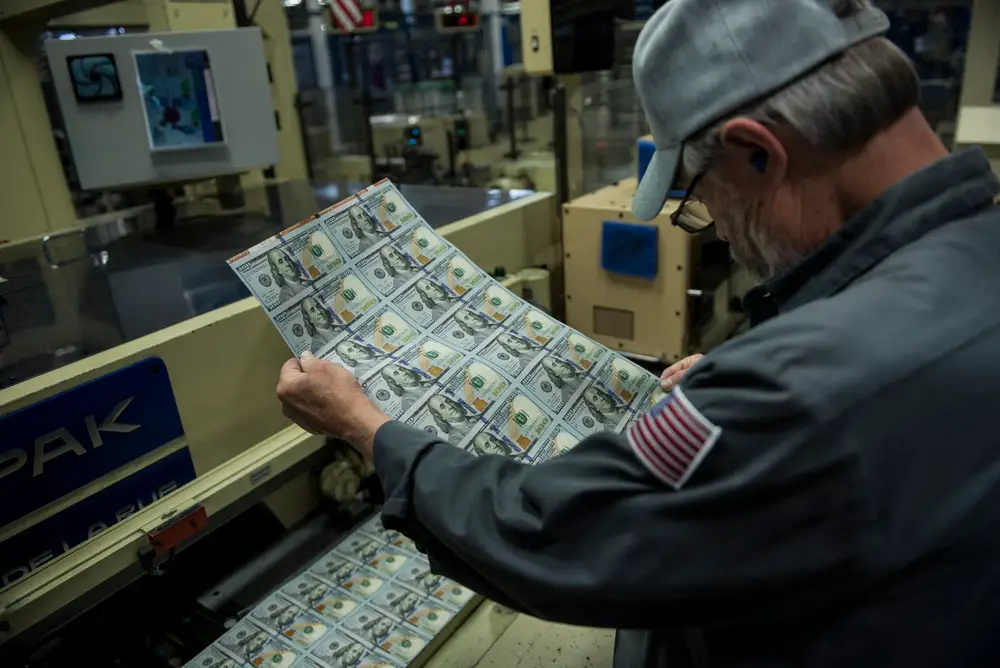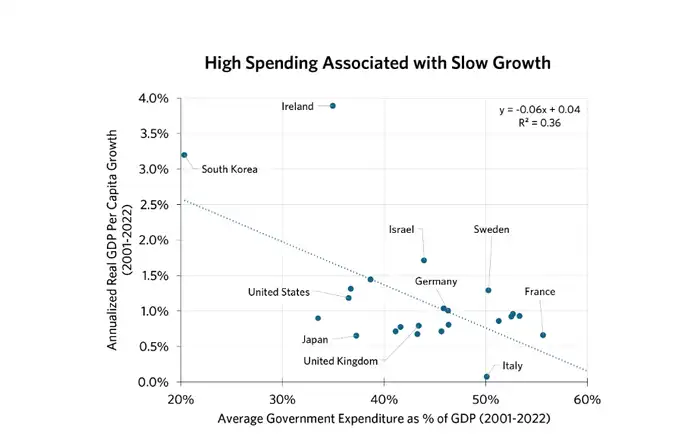The national debt crisis is set to worsen no matter who wins the election — here’s what you can do to protect your portfolio

A US Bureau of Engraving and Printing’s Western Currency Facility employee overlooks newly printed hundred dollar bills.
The US has a big, $35 trillion problem: the national debt.
After a bout of pandemic stimulus, the national debt ballooned from an already hefty 103% of GDP in 2019 to 120% currently.
Left unchecked, the deficit will continue to creep higher and could drag GDP growth. Too much government spending reduces public and private savings levels, decreases labor productivity, and increases our dependence on foreign investment, according to Chris Brightman, CEO and CIO of the investment advisory Research Affiliates.

If the US debt continues on this trajectory, Brightman predicts that the US could follow in the footsteps of European economies and see annual GDP growth decline to 1%.

That’s not to mention that welfare programs like Social Security will be on the chopping block. According to the Social Security Administration, Social Security benefits will be reduced by almost 25% starting in 2034 if nothing is done to address the national debt.
No change in November
Neither Harris nor Trump have a plan to address the deficit.
In fact, both candidates are pushing policies that would increase deficit spending. If there’s a blue or red sweep in November, government spending levels will be even higher.
There are two main ways to reduce deficits, according to Ayako Yoshioka, senior portfolio manager at Wealth Enhancement Group. The first is to grow your way out. By growing the economy at a faster rate, the proportion of debt to GDP decreases.
“Nobody wants to really think about Plan B. Plan B is either raising taxes or cutting social programs and raising taxes when inflation is high,” Yoshioka said.
Both of those policies are incredibly unpopular, which is why the candidates haven’t said much on the topic.
However, growing GDP won’t be sufficient to fix the situation, according to Brightman. “The math doesn’t work,” he said. If GDP continues to grow at its predicted pace of 2% per year, that’s not even enough to cover the US government’s interest payments on debt, much less reduce the principal amount. Interest costs are projected to reach 3.4% of GDP by 2025, and 4.1% by 2034.
How to invest
Until the government takes steps to get the deficit under control, there are a few things investors can do to protect their holdings.
Continued high national deficits could put the credibility of US sovereign debt into question, leading to a depreciating dollar and increased inflation.
The US government might try to use inflation to chip away at the real value of the debt by pursuing expansionary monetary policies such as quantitative easing, according to Jeff Muhlenkamp, portfolio manager at Muhlenkamp & Company. If the US dollar were to decrease in value, the government could repay the debt more cheaply than when it was first incurred.
“As the US government continues to get deeper in debt, how are they going to work their way out of that?” Muhlenkamp said. “One of the potential outcomes ends up being a devaluation, and gold is a nice hedge against that.”
“Real” assets, or investments backed by tangible resources, are generally a good hedge in a high-debt environment, according to JPMorgan. These investments have direct intrinsic value and tend to store long-term value effectively. Examples include commodities, real estate, and infrastructure. Muhlenkamp likes the energy sector in particular. JPMorgan also recommends increasing exposure to non-US dollar-denominated assets.
Avoid long-term Treasurys, Muhlenkamp added.
“Where you definitely don’t want to be is in long-term government debt,” he said. “[The government] will inflate away the value of the debt if they can get away with it.”
Muhlenkamp is predicting that the next decade will see increased inflation, which will eat away at bond yields.
Yoshioka points out that there’s also the risk of a failed treasury auction, which is when the Treasury Department doesn’t receive enough bids to take on the debt it’s trying to sell. If this were to happen, the Federal Reserve would need to step in and purchase the unwanted bonds by printing money, creating more inflation.
Some funds that offer exposure to real assets include the iShares US Energy ETF (IYE), the Fidelity MSCI Real Estate Index ETF (FREL), and the iShares Gold Trust (IAU).






